It was great to get out in the June sun, to meet volunteers and staff working on the Wild Ingleborough project. Before my visit, I had thought that I knew the area well. I had learned to paraglide on Ingleborough and caved under it for years - Ingleborough has some of the best caves in the country!
Sara joined staff and volunteers who were repairing drystone walls on a volunteer Task Day and chatted to Wild Ingleborough Project Officer, Liz Coates, who explained why drystone walls are so important and how volunteers are vital to the project.
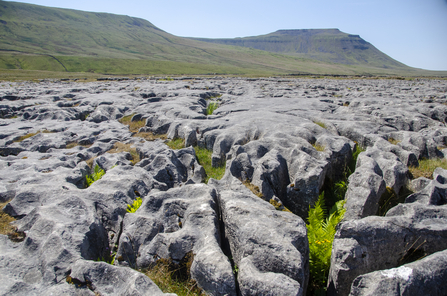
Known for its botanical richness the limestone pavements at Ingleborough are thought to have been formed by glaciers 30 million years ago, during the Carboniferous period - Photo taken by Sara
I strolled to the task location with Liz Coates, the Wild Ingleborough Project Officer. As we chatted, I soon realised how much I didn’t know about the area...
Liz was a real expert. She explained that the Wild Ingleborough project site is located on the Ingleborough Massif, in a landscape that has historically become severely nature-depleted. The area includes the Ingleborough NNR and several YWT reserves, as well as existing small pockets of native woodland and natural habitat. Liz described how the Wild Ingleborough project is helping nature thrive with this innovative landscape-scale conservation project.
The project is working to restore around 1,200 hectares of land owned by Natural England and YWT, it reaches from the valley floor, to the 650m high Simon Fell. A key aim is to reconnect patches of habitat to allow wildlife to move more freely in the landscape. To achieve this, YWT is working in partnership with five other organisations: Natural England; WWF UK; the University of Leeds; the United Bank of Carbon and the Woodland Trust. Each brings something different to the project, to combat the impacts of the climate crisis and aid nature’s recovery.
The project works alongside regular YWT Dales volunteers, who have been caring for YWT’s Ingleborough reserves, for the last 50 years. Liz reported that Wild Ingleborough has been strongly supported by volunteers, who have contributed an amazing 2,700 hours since 2021. I was soon being introduced to two of those volunteers who were being supported by two project team members who were all there to help repair the drystone walls.
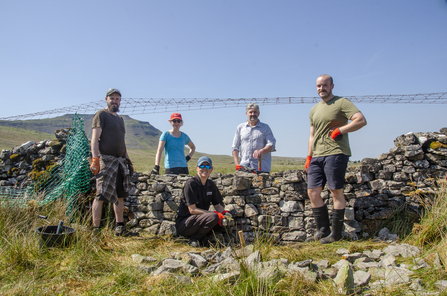
Wild Ingleborough volunteers have contributed an amazing 2,700 hours to the project since 2021 - photo taken by Sara
The team explained that the day’s task was to rebuild a length of drystone wall that was in poor condition and that wouldn't stop livestock from getting into the reserve. Last week’s task had been to carefully take down the damaged section. This involved grading the stones to allow them to be picked up in order: larger stones at the bottom of the wall, then smaller ones. The smallest stones were used as fill. Finally, the capping stones were kept to one side so they could be replaced locking the wall into place.
I also learned that walling stones have a right way round, with a pretty side and slight taper being desirable - always leaving a one-meter space at the base of the wall, to avoid tripping over stones.
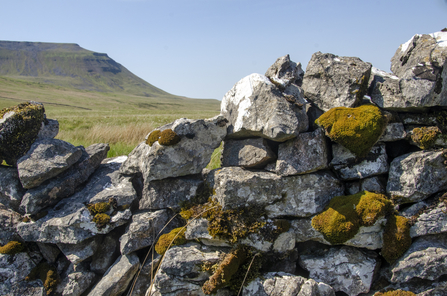
Repairing drystone walls is important to control livestock entering our reserves to prevent over-grazing - photo taken by Sara
Ingleborough has drystone walls that are 700 years old. This means that caring for them is an important part of looking after our cultural heritage. There isn’t a figure for all of Wild Ingleborough’s drystone walls. Liz reported that just on Natural England’s land alone, there are 60km of drystone wall. That is a lot of walls requiring care and maintenance. It is estimated there is a total of over 8,000km of drystone walls in the Yorkshire Dales. The team explained that walls are a very special habitat: bare rock, at a steep angle to the sun. This supports different wildlife to the clints and grikes (upstanding blocks in the stone with water-worn channels) of the Ingleborough’s limestone pavements.
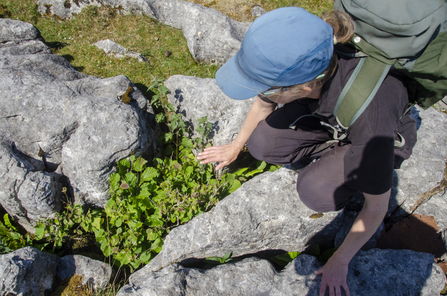
Liz showing a sheep nibbled tree in the limestone paving - photo taken by Sara
The shade and security of drystone walls provide habitat for a wide range of creatures, from invertebrates such as the violet ground beetle to birds such as the little owl. The walls also keep sheep out and cattle in, when in good condition. This is important as cattle graze differently to sheep, tearing out mouthfuls and moving on, rather than nibbling vegetation to a bare minimum. Liz showed me how sheep even graze down trees in the limestone pavements, so that they cannot grow higher than the sheep can reach down.
As well as grazing differences, cows’ hooves also make holes, with the disturbed ground being great for insects. I was staggered when Liz showed me an area that had been securely walled from all stock for years – it was jam-packed with small trees and berry-bearing shrubs.
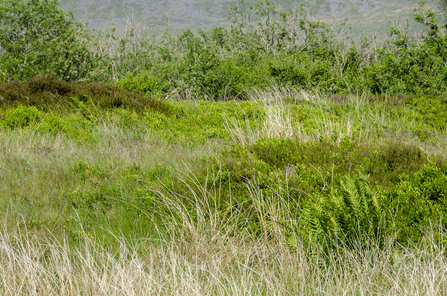
An area of jam-packed with vegetation, including small trees and berry bearing shrubs. where stock has been excluded for years - photo taken by Sara
As I learned on my visit, there is always something new to learn even about a place you think you know well. Everyone is welcome to visit Wild Ingleborough most of which is open access land. At this time of year, Liz suggested visiting Southerscales, for its lovely orchids and other flowers. She added that you can arrive by train to nearby Ribblehead Station.
Do have a look at the Wild Ingleborough Project website. And why not sign-up for a volunteer task? These vary through the year from drystone walling to tree planting, incorporating corporate days, family celebrations and community events. Find out more about the Wild Ingleborough Project here
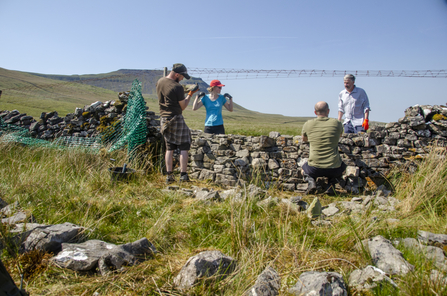
It is estimated there is a total of over 8,000km of drystone walls in the Yorkshire Dales, photo taken by Sara

